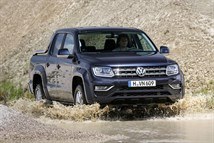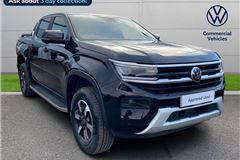Volkswagen Amarok (2011 – 2023) Review
Volkswagen Amarok (2011 – 2023) At A Glance
Volkswagen isn't a make you'd associate with the traditionally rough and ready pick-up truck. It's a market that's dominated by Japanese brands such as Mitsubishi and Toyota whose reliability and tough build quality has made them favourites among plenty of owners. Volkswagen hasn't been deterred though.
It leads the way for commercial vehicles in Europe with models like the Transporter and Caddy, so the Amarok is a logical step.
It may not have the tough image of the Toyota Hilux but the Amarok majors on comfort and refinement. It's very quiet on the move, rides well and has a comfortable interior with a quality finish that's on par with Volkswagen's car range. It's very easy to forget you're in a pick-up truck and inside it's a cut above most of the competition.
At launch the Amarok was offered with a choice of 2.0-litre four-cylinder turbodiesel engines. Designed for efficiency the common rail unit is quiet and pulls well enough thanks to 340Nm of torque in the standard version (the BiTDI has 400Nm) but it doesn't quite feel strong enough compared to some of its rivals.
In 2016 Volkswagen replaced the 2.0-litre turbodiesels with a 3.0-litre V6. Smooth, powerful and quiet, the V6 gives the Amarok the punch it was lacking with the older four-cylinder units. The 3.0-litre is offered in 204PS and 224PS (240PS with overboost). Early 2018 would see VW add a 258PS version of the V6 engine, it featuring an overboost function for 272PS for short periods under heavy engine loadings.
It has a good sized load space though with 2.5 square metres and a length of more than 1.5 metres so it can carry a Euro pallet sideways. The maximum payload is in excess of one tonne in the majority of models. It's well equipped too with even the standard model getting 16-inch alloy wheels, 4MOTION Selectable four-wheel drive, electric front and rear windows, semi-automatic air conditioning and a CD radio.
Used Buying Guide - Volkswagen AmarokFrom the powerful V6 to the early 2.0-litre turbodiesels, we explain what you should look out for when buying a used second-hand Amarok one-tonne pick-up truck. |
|
Driving the Volkswagen Amarok (2011 – 2023)
The Amarok is powered by the familiar 2.0 TDI common rail diesel that's used across the Volkswagen range. It's a smooth and refined engine that's a world away from the old PD TDI engines that the brand used to use but still seems a small engine when the competition all use larger diesels - the L200 has a 2.5-litre diesel as does the Hilux.
The entry-level model comes with a 122PS version of the 2.0 TDI with 340Nm which emits just 199g/km of CO2 - impressively low for a pick-up. All other models come with a more powerful 2.0 BiTDI engine which as it's name suggests has twin turbochargers to boost performance. The extra turbo boosts power to 163PS along with 400Nm of torque which is available from 1500rpm.
The engine will trickle down to 1000rpm but won't pull from there and the catapult effect of the turbos is very obvious from 1,500rpm. This is as good as it can get using a 2.0-litre engine in a big pick-up, but it really needs a 2.5-litre or a 3.0-litre to feel relaxed. The benefit of course is low CO2 and the potential of good economy of 35.8mpg.
It's certainly refined and pleasant to drive with a light load on board. The standard six-speed gearbox is positive and the steering is responsive, not requiring too many turns from lock to lock. As a result it's reassuring in corners and easy to drive in town. As with all pick-ups, the Amarok is very tyre dependent and we're pleased to report the availability of 70 profile Pirelli Scorpions.
In 2012 Volkswagen introduced an Amarok Automatic which is fitted with an eight-speed automatic gearbox and powered by a 2.0 BiTDI with 180PS and 420Nm. It's a very smooth and refined gearbox which makes the most of the Amarok's power and still works well on off-road terrain.
The 4WD is an on demand system on most models although you can opt for a permanent 4WD version on Highline trim models. This version comes with a comfort suspension set-up designed for lighter use and mainly on-road driving. It has a trapezoidal spring pack which offers greater suspension, vibration and noise comfort. However it's important to note that this version has a payload of just 750kg and as this figure is under one-tonne HMRC classes it as a car and not a commercial vehicle.
The Amarok with the standard selectable 4Motion transmission has a ‘heavy duty’ rear suspension system designed to cope with off road terrain and heavier loads. Take the Amarok off road and it performs impressively well. It has all the systems you'd expect with a centre differential lock that automatically acts on all wheels to increase traction by directing power to the wheels with the best grip.
You need to stop to engage or disengage low range but it does have an electronic hill descent control and a hill holder. This allows you to descend inclines with your feet off the pedals while the hill holder holds the vehicle for three seconds so there is time to get off the footbrake and on to the accelerator after selecting first gear. The Amarok’s braked trailer weight towing limit is 2690kg. Unladen weights range from 2051kg to 2106kg (depending on model), with a 5500 kg gross train weight.
The Amarok would continue with the range of four-cylinder engines until Volkswagen replaced them with a 3.0-litre V6 as part of its 2016 model year revisions. The new 3.0-litre is offered in 204PS and 224PS (240PS with overboost). All were initially only offered with the eight-speed automatic, though the 204PS and a lower-power 163PS would be offered with six-speed manuals in 2017 in Trendline trim. The manual transmission allows a low-ratio transfer box for those wanting ultimate off-road ability. Early 2018 would see a 258PS version of the V6 engine introduced with an overboost function for 272PS for short periods under heavy engine loadings.
Volkswagen Amarok (2011 – 2023) interior
Sit behind the wheel of the Amarok and it's easy to think you're driving a Volkswagen passsenger car. Apart from the huge square bonnet stretching out ahead of you of course. There's plenty that's familiar though with similar dials, switches and the same steering wheel from the likes of the Golf and Passat. The Amarok is certainly no poor relation to the rest of the Volkswagen range, just because it's a pick up.
The quality of the interior is good too. It's comfortable and has a more upmarket feel than you'd expect of a pick-up, yet still feels robust and hard wearing enough to be able to cope with the everyday rigours that working pick-ups have to endure. There's good storage too with twin cupholders in the middle and a large central box complete with armrest, between the seats.
Most versions of the Amarok are the double-cab which has five-seats thanks to a rear bench that can accommodate three adults fairly easily. Usefully the rear bench can also flip forward to create extra carrying space. The driver's seat adjusts for height, reach and rake so it's easy to get comfortable and even after long journeys you're unlikely to ache thanks to the supportive yet comfortable seats. An entry-level single cab version, more of a workhorse vehicle, was added to the range in mid 2012.
The interior does of course vary depending on the trim level. The Startline is the ideal workhorse with rubber flooring, electric windows and Climatic semi-automatic air conditioning. The Trendline is a bit nicer with floor carpet, ‘Climatronic’ air conditioning, a leather-covered steering wheel and a trip computer. The top Highline models have leather upholstery and heated front seats.
The load area is 1555mm long and capable of carrying a Euro pallet sideways while the big tailgate feels robust, even when you repeatedly drop it down. The load area itself comes lined as standard and like the rest of the car it feels well finished and robust enough to withstand every day abuse. There is also the option of a lockable toolbox which fits across the load bay plus of course a variety of tonneau covers including a hinged aluminium version, a roll-up waterproof fabric or even a complete matching hardtop.
The single cab model has a load area of more than 2.0 metres (2205mm to be precise) and can carry two Euro pallets sideways with 60cm to spare. The load area is 3.57 square metres in total and it comes with six lashing hooks as standard.
Volkswagen Amarok (2011 – 2023) models and specs
| Dimensions | |
|---|---|
| Length | 5254 mm |
| Width | 1444–1954 mm |
| Height | 1834 mm |
| Load Volume | 2.0–2.5 m3 |
| Miscellaneous | |
|---|---|
| Kerb Weight | 2025–2134 kg |
| Payload | 750–1145 kg |
| Warranty | 36/100,000 24/Unlimited |
| Servicing | Variable |
Double Cab Pick Up
Model History
- November 2010: Amarok awarded 4 star Euro NCAP rating
- January 2011: New Volkswagen Amarok is launched in the UK
- February 2011: Pricing for the Volkswagen Amarok revealed
- November 2012: Volkswagen announced power upgrade for BiTDI engine
- June 2013: Amarok edition launched
- January 2014: Amarok Ultimate launched
- January 2014: Volkswagen Amarok Canyon introduced
- August 2014: Amarok Atacama introduced
- September 2014: Volkswagen Amarok Dark Label special edition introduced
- November 2016: Amarok V6 TDI launched
- November 2017: Manual Amarok introduced
- January 2018: Amarok Dark Label re-introduced
- February 2018: Volkswagen Amarok Trendline 3.0 TDI 163PS launched
- April 2018: Volkswagen adds 258PS V6 to Amarok range
- November 2018: Amarok Aventura launched
November 2010
Amarok awarded 4 star Euro NCAP rating
The Volkswagen pick-up received ratings of 86 per cent Adult Protection, 64 per cent Child Protection, 47 per cent Pedestrian Protection and 57 per cent Safety Assist. ESP is standard on all models.
January 2011
New Volkswagen Amarok is launched in the UK
The new pick-up from Volkswagen made its UK debut at the 2011 Outdoors Show at the ExCel exhibition centre in London’s Dockland.
February 2011
Pricing for the Volkswagen Amarok revealed
Volkswagen's new pick-up is available in three trim levels, starting at £16,995 for the Startline model and £18,995 for the Trendline, while the range-topping Highline will cost from £21,575.
The four-wheel drive double-cab is available with the choice of two refined diesel engines. All models can be fitted with the powerful, yet efficient, 2.0-litre BiTDI 163 PS engine, while an entry-level 2.0-litre TDI 122 PS is also offered on Startline models.
November 2012
Volkswagen announced power upgrade for BiTDI engine
Up from 163PS to 180PS plus the introduction of BlueMotion Technology models to offer improved efficiency. Towing limits have also increased from 2800kg to 3000kg for manual models, while a new eight-speed automatic transmission has been introduced and has a higher towing limit of 3200 kg.
At the same time, new features introduced include Bluetooth, front and rear parking sensors, heated washer jets, tachograph preparation, cornering fog lights and 19-inch alloy wheels.
BlueMotion Technology improves fuel economy and lowers emissions by using low rolling resistance tyres, Stop/Start and regenerative braking. This means that although the 180PS BlueMotion Technology is over 10 per cent more powerful than the previous 163PS model, it is more economical, with a combined fuel economy of 37.2mpg compared to 35.8mpg. Emissions drop by 10g/km to 199g/km.
Torque for the eight-speed automatic transmission increases from 400Nm to 420Nm, delivered at 1750rpm. It is available exclusively as a Highline model with BlueMotion Technology and permanent 4MOTION for a retail price of £25,105 (plus VAT). It achieves combined fuel economy of 35.3mpg with emissions of 211g/km – the same as the standard manual model.
June 2013
Amarok edition launched
Based on the Trendline model it adds extra equipment worth £3400. Just 300 will be available in the UK.
To make it stand out the new model comes with 18-inch Durban alloy wheels, black bars across the load bed, privacy glass, black and red side stripes and 18-inch Durban alloys. On top of that there are front and rear parking sensors and a protective coating for the load area. Inside it has Bluetooth, sat nav and a five-inch colour touchscreen.
January 2014
Amarok Ultimate launched
Limited to only 500 vehicles, the Amarok Ultimate showcases Volkswagen’s purposeful design and features a host of premium features that make it a truly unique package.
The exterior design is distinguished by xenon headlights, 19–inch Aragonit polished alloy wheels and double chrome strips on the radiator grille. Available for the first time on an Amarok are striking LED daytime running lights that frame the headlights and give the vehicle a unique light signature at night.
Standard equipment also includes electrically foldable, heated and adjustable door mirrors featuring enhanced chrome detailing. Darkened tail light lenses and a new LED number plate light complete the exclusive exterior design package.
The Amarok Ultimate’s sleek appearance is matched by the power that drives it. The model comes with Volkswagen’s top of the range 2.0-litre BiTDI 180PS engine, offering up to 420 Nm of torque and a maximum towing capacity of up to 3200 kg.
January 2014
Volkswagen Amarok Canyon introduced
A limited number of 350 vehicles will be available to UK customers when the Canyon goes on sale on 1 April. Based on the Trendline trim the Amarok Canyon gets more than £8,500 worth of extra equipment including satellite navigation with a six-inch colour touchscreen, Bluetooth, unique styling bars, 19-inch Cantera alloy wheels and heated leather seats.
There are also front and rear parking sensors, privacy glass, a protective coating for the load area, a matt black roll cover, interior floor mats and high-gloss black side styling bars and rear bumper. Inside there is a combination of Nappa and Vienna leather upholstery in two-tone Moonrock (light grey) and Anthracite (dark grey). Other extra inclide a leather-covered steering wheel and gear lever with orange stitching.
When ordered in Copper Orange the air vent surrounds are matched to the vehicle’s exterior colour, while on the Deep Black and Reflex Silver models the air vent surrounds feature Matt Chrome. Those wishing to enhance further the look of this special-edition Amarok can add the optional roof light bar for only £945 (ex. VAT).
The Canyon comes with the 2.0-litre BiTDI 180 PS engine, offering up to 420 Nm of torque and a maximum towing capacity of up to 3,200 kg. Customers can choose between a six-speed manual with selectable 4Motion (50 vehicles available) or an eight-speed auto with permanent 4Motion (300 vehicles available).
The Amarok Canyon is available in three colours: Copper Orange, Reflex Silver or Deep Black – with Indium Grey foil lettering and Silver under ride guard. Retail prices start from £28,990 (excluding VAT) for the manual transmission and rise to £30,720 (excluding VAT) for the automatic transmission.
August 2014
Amarok Atacama introduced
The new Amarok Atacama is priced from £26,850 (basic excl. VAT) and is powered by a 2.0-litre BiTDI 180PS engine with a choice of two transmissions: a six-speed manual with selectable 4MOTION four-wheel drive or an eight-speed automatic with permanent 4MOTION four-wheel drive as standard.
Available in three colours – Candy White, Horizon Blue and Deep Black – the Amarok Atacama comes with a raft of design and styling features that give it a striking look. These include xenon headlights, black rear styling bars, black rear bumper with integrated step and 19-inch ‘Cantera’ alloy wheels. The load bed features a ‘Durabed’ protective coating, while distinctive black foil finish on the B-pillars and unique ‘Atacama’ side decals complete the design package.
Inside, it gets Vienna leather upholstery, a newly designed leather multi-function steering wheel, Bluetooth phone connectivity, RNS310 navigation and Climatronic 2-Zone air conditioning.
September 2014
Volkswagen Amarok Dark Label special edition introduced
Fitted with 2.0-litre BiTDI 180 PS engine, spec includes 18-inch Durban alloy wheels finished in black, extended wheel arches and a distinctive underride guard below the front bumper. Also dark tinted rear/side windows, darkened tail lights, matt black side bars and footstep, along with a black rear bumper, black grained door handles and black foil on the B-pillars.
Inside, premium anthracite Alcantara upholstery and velour floor mats featuring exclusive Dark Label branding. Equipment includes a multi-functional steering wheel, leather gear knob and gaiter, satellite navigation with a six-inch colour touchscreen, Bluetooth, a multi-function display and heated seats. Heated door mirrors, electric windows and additional door dust seals are also standard.
A special anthracite-coloured UV-resistant special coating applied to load area completes the striking look. Choice of three colours: Deep Black, Reflex Silver and Natural Grey. Amarok Dark Label accessories include a hard tonneau cover, Dark Label branded seat covers and bonnet protection, and styling items including chrome door handles and roof-mounted styling bar lights.
Prices start at £26,125 (excluding VAT) for the 2.0 BiTDI 180PS 4MOTION Selectable manual model, with the 2.0 BiTDI 180PS 4MOTION Permanent with eight-speed automatic costing £27,855 (excluding VAT).
November 2016
Amarok V6 TDI launched
The top-of-the-range version of this 3.0-litre V6 delivers 224PS and 550Nm torque channelled through a standard eight-speed automatic transmission, giving a top speed of 119mph and a 0 to 62 mph time of 7.7 seconds.
An overboost function on the 224PS raises the power to 240PS. Further versions of this V6 TDI engine include a 204PS, which is available to order at launch with an automatic gearbox, plus a manual 204PS and a 163PS manual to follow later in 2017.
Offering car-like comfort and technology with full off-road capability, UK customers can choose from selectable (with manual gearbox) and permanent (with auto) 4MOTION four-wheel drive. An optional mechanical rear-axle differential lock is also available for demanding off-road use.
The Amarok V6 is distinguished itself from the previous 2.0 TDI through new front bumper and radiator grille design including front fog lights, new alloy wheels and a third brake light with LED technology.
Inside the cab, changes include an all-new dash panel design which incorporates Volkswagen’s MIB infotainment system with touchscreen, radio and new technology including the option of navigation, Guide & Inform, Car-Net and App-Connect systems. Bluetooth and DAB digital radio are also now standard features.
UK specifications follow the previous model’s pattern and range from Startline (later in 2017), through Trendline to Highline. Special editions will also be offered during the model’s life, for example the range-topping Aventura, 240 examples of which are available from launch.
Aventura equipment includes bi-xenon headlights with integrated LED daytime running lights, 19-inch alloy wheels with 255/55 tyres and arch extensions. The cargo bed of the Aventura also has a matt black Durabed coating. The interior features ‘Discover Media’ navigation system and mobile online services. The Aventura also comes with ParkPilot automatic parking system, featuring front and rear parking sensors and a reversing camera. This model is available in exclusive Ravenna Blue metallic paint finish.
| Model | Engine | Basic RRP exc. VAT | Total RRP inc. VAT | Total RRP inc. OTR exc. VAT | Total RRP inc. OTR inc. VAT |
| Trendline | 3.0 V6 TDI 204 PS 8spd auto 4MOTION | £26,255.00 | £31,506.00 | £27,125.00 | £32,493.00 |
| Highline | 3.0 V6 TDI 204 PS 8spd auto 4MOTION | £29,995.00 | £35,994.00 | £30,865.00 | £36,981.00 |
| Highline | 3.0 V6 TDI 224 PS 8spd auto 4MOTION | £30,495.00 | £36,594.00 | £31,365.00 | £37,581.00 |
| Aventura | 3.0 V6 TDI 224 PS 8spd auto 4MOTION | £31,995.00 | £38,394.00 | £32,865.00 | £39,381.00 |
November 2017
Manual Amarok introduced
Available with the 204PS engine it reduces the entry price of the range by over £650 to £25,600.
The new model, available in Trendline trim, combines a six-speed manual gearbox and at the touch of a button, selectable all-wheel drive, with a drive system that features standard rear-wheel drive and, when required, engages the front axle. Thanks to the manual gearbox, an additional off-road gear reduction function permits extreme crawling pace, helpful when navigating complicated passages off-road and scaling particularly steep inclines of up to 100 per cent (slope angle of 45°).
It has a combined fuel economy of 32.5 mpg and CO2 emissions of 229g/km. The zero to 62 mph sprint takes just 8.4 seconds – faster than its automatic counterpart at 9.1 – and it has a top speed of 119 mph (vs 117 for the auto).
Weight-wise, the manual 204 PS Amarok has a GVW of 3200 kg, braked trailer weight of 3000 kg, and a payload of 1050 kg.
January 2018
Amarok Dark Label re-introduced
The Amarok Dark returns and is priced from £33,650. Based on the Amarok Highline, the Dark Label gets 18-inch Rawson alloy wheels, matt black mirror housings, black door handles and a black rear bumper.
Standard paint is exclusive Carbon Steel grey metallic, along with side bars and a rear styling bar finished in matt black plus underbody styling and unique Dark Label decals
The seat trim covers are finished in Alcantara with black headlining and vent bezels trimmed in chrome silk gloss. Both front seats are equipped with manual lumbar adjustment, while the footwells are adorned with unique Dark Label floor mats. The Discover Media with 6.33-inch touchscreen is fitted as standard, and comes with Voice Enhancer and Guide & Inform.
The Amarok Dark Label is powered by the 3.0-litre V6 engine that generates 204PS and 500 Nm of torque. Drive is delivered to the road via an eight-speed automatic gearbox and a permanent 4MOTION four-wheel drive.
Production is limited to around 200 units with order books for the Dark Label closing in April 2017.
February 2018
Volkswagen Amarok Trendline 3.0 TDI 163PS launched
Priced at £24,510 (basic, excluding VAT and OTR).
The 163PS 3.0 TDI sits below its 204PS and 224PS siblings in the new line-up, yeat still offers a substantial 450Nm torque. With 24 valves and overhead camshafts, it meets the latest Euro 6 emissions standard, and features fuel-saving BlueMotion Technology advances.
The Amarock V6 3.0 TDI 163PS has a Gross Vehicle Weight (GVW) of 3200kg, a maximum payload rating of 1,073kg and can tow up to 3,000kg (braked trailer). It can reach 62mph from rest in 9.8 seconds and has a top speed of 110mph. CO2 emissions are 228g/km, while fuel consumption on the combined cycle is 32.5mpg.
The Amarock 3.0 TDI is available in Trendline trim only, and equipment includes 17-inch Posadas alloy wheels, Climatronic air-conditioning system, Composition Media Radio with 6.33-inch touch screen, App-Connect and cruise control. Order books for the new model opened February 2018, with the first deliveries from May 2018.
April 2018
Volkswagen adds 258PS V6 to Amarok range
Developing 258PS, the Amarok V6 rivals the Mercedes-Benz X-Class V6
The 3.0-litre V6 turbodiesel is boosted to 258PS and 580Nm of torque, with the latter flowing from 1400rpm - 3000rpm. Amarok gets an overboost feature for overtaking, with the V6 engine producing 272PS for short bursts under heavy acceleration. Power is fed to the 4Motion all-wheel drive system via an eight-speed automatic gearbox.
Available in Highline or Aventura trim, Volkswagen's pick-up is offered with some suitable visual upgrades, including a black roof liner, 20-inch wheels, leather seats and LED daytime running lights.
Highline adds a host of features on top of the standard Amarok’s already generous specification. As well as items including ABS, ESP and automatic post-collision braking system, climatronic air conditioning, Composition Media infotainment system with touchscreen and App-Connect, Highline gains 18-inch alloy wheels, bi-xenon headlights and side bars, front and rear parking sensors with rear-view camera and Vienna leather upholstery.
The new 258 PS Amarok can be ordered now. Prices for the new Highline model with 258PS engine start at £34,325 (basic, excluding VAT and OTR). The entry-level model to the range, the 163PS Trendline, costs £24,510 (basic).
November 2018
Amarok Aventura launched
The Amarok Aventura features 20-inch Talca alloy wheels, body coloured sports bar with Aventura badging and chrome-plated side bars with step and LED spot lighting.
Customers can specify their Aventura in a range of colours and can also take advantage of a reduced price for special matt finishes. Available in either Ravenna Blue or Indium Grey, the matt paint can be specified as a £2,335 (ex VAT) option. Also available are Mountain top roll covers made specifically for the Aventura model. Available in black or silver, they can be specified as an option for £1387.50 (ex VAT).
Powering the new Amarok Aventura is a 3.0-litre TDI V6 with 258PS in normal driving and 272PS when using the overboost function. The engine generates 580Nm of torque with 4MOTION all-wheel drive and an 8-speed automatic gearbox. The special edition Amarok Aventura is priced at £39,960 (OTR exc VAT).

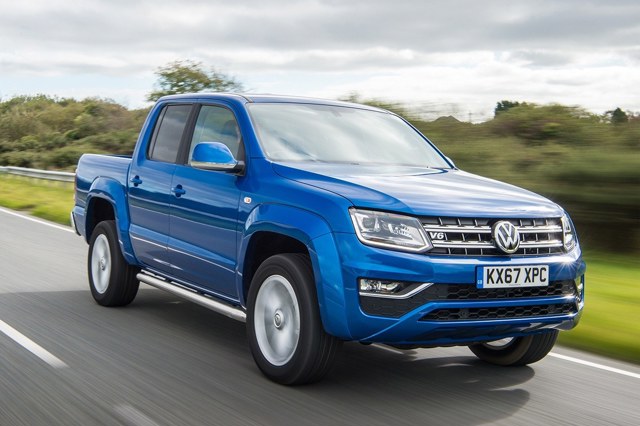
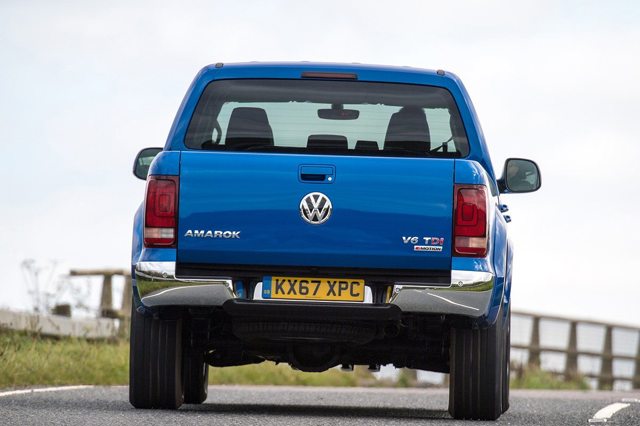
.jpg?width=640&height=426&rmode=crop)
.jpg?width=640&height=426&rmode=crop)
.jpg?width=640&height=426&rmode=crop)
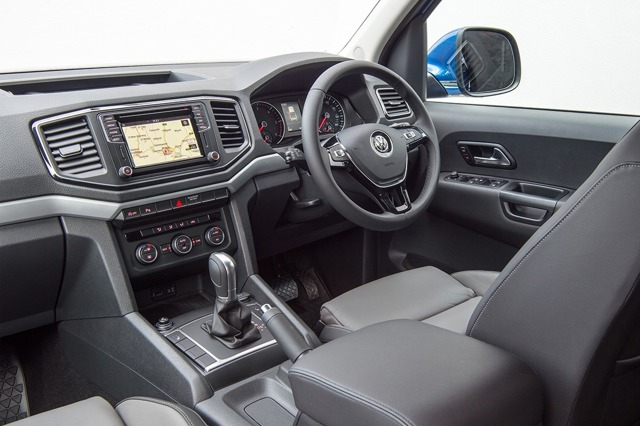


 Impressive on road and easy to drive off road, refined, six-speed transmission with low range. Vastly improved V6 TDI from 2016 can tow 3.2 tonnes and has outstanding AWD system.
Impressive on road and easy to drive off road, refined, six-speed transmission with low range. Vastly improved V6 TDI from 2016 can tow 3.2 tonnes and has outstanding AWD system.
 Original 2.0 TDI has low CO2 and is reasonably economical but not really strong enough for tough work.
Original 2.0 TDI has low CO2 and is reasonably economical but not really strong enough for tough work.
